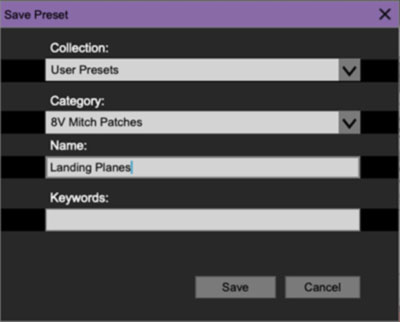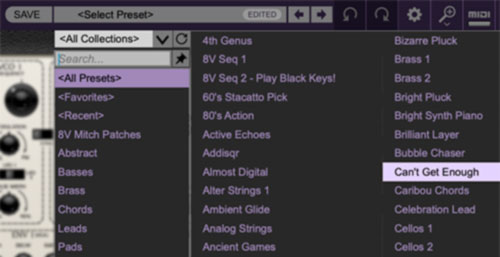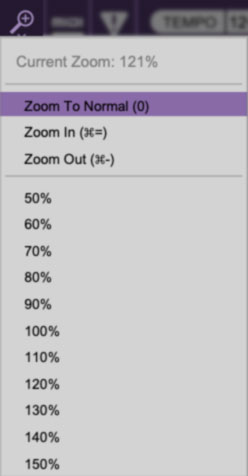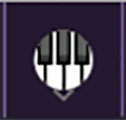
The purple strip at the top of the Eight Voice is contains all of the preset loading and saving navigation, "under-the-hood" settings, zoom and focus controls, and more.
Even if you breeze through this section, makes sure to check out the Focus controls - they make Eight Voice's Really Big User Interface WAY easier to use.
New- Opens a new blank patch preset. If an unsaved patch is currently open or you’ve modified an existing saved patch, a dialog asks if you’d like to save the patch in its current state. This greatly reduces the possibility of losing an edited unsaved patch.

Save- Use this to save patches. There are a couple of levels of hierarchy:
Collection- This is the top level of organization, and contains entire “sets” of presets. The Eight Voice Presets are the main included collection. We also include a User Presets Collection for storing your own presets, but you’re free to create your own collections. To create a new collections, click in the Collection text field (where it says User Presets above) and type a name. User-created sounds can be freely saved to any collection; we like to keep ‘em separated for organizational purposes.
Categories- Within each Collection are a number of sound categories. As with collections, you’re free to create as many categories as you like. To create a category, click in the Category text field of the Save dialog window and type a new category name.
Patch- A patch is an individual sound. To save a patch, simply type the name in the Name field and click Save.
Keywords- You can add descriptive words such as “huge,” “noisy,” “poly,” etc., to patches to make them appear when terms are typed in the Search field. Use commas to separate multiple keywords entries.

Browsing Patches- Patches can be browsed by clicking the <Select Preset> field. To select a preset collection, click in the area that says <All Collections> or on the downward-facing arrow next to it.
Clicking on the left-side categories narrows down which patches are displayed.
<All Presets> will show presets from all collections and categories.
<Recent> displays recently used presets.
Refresh- This is the circular arrow button to the right of the downward arrow; clicking this checks the Cherry Audio server for new or updated presets.

Pin- Clicking the push-pin icon locks the patch selection list open, allowing fast and easy browsing and auditioning of patches. Click the icon again to disable pin mode. when in pin mode, the up and down arrow keys can be used to select patches.
Preset- Step Back/Forward Arrows- These step to the previous or next preset. macOS [⌘+left/right arrow key] or Windows [CTRL+left/right arrow key] will navigate through presets back and forth in the currently selected collection/category.
Undo/Redo- These circular arrows will undo or redo the last action. It remembers many steps, so if you really loused something up, keep on clickin'...
Settings- This is where user preferences for user interface, audio interfaces, user account, and more are configured. See the Settings section for full information.

Importing Presets with drag-and-drop
Presets can be imported singly or en masse (as a single compressed ZIP file) simply by dragging and dropping from the desktop anywhere on the user interface.
If a single .*preset file is dragged and dropped, the sound is immediately loaded and the standard Save Preset dialog appears; this lets you save the sound to the instrument's preset browser. Note that you don't have to save the sound to preset browser; if you just want to hear and play the sound, click the Cancel button in the Save Preset dialog - the sound will still be loaded.
Compressed zip files containing multiple sounds can also be drag and dropped onto the UI. This works the same as with single sounds, but instead of the Save Preset dialog, you'll see the Import Preset Collection dialog. The presets will be added as a new collection and available in the categories for which they were tagged.
Zoom Magnifying Glass- Click to resize the Eight-Voice interface. Selecting 100% returns the user interface to native size.
MIDI Tab- Opens the MIDI controllers tab for configuring internal and hardware MIDI controls. See the MIDI Controllers Setup and MIDI Tab section for full information.
! (MIDI Panic)- Click to send an all-notes-off message in case of, "make this dang thing shut up?!?" stuck-note incidents.
Tempo (Standalone Version Only)- Displays Eight Voice's current internal tempo setting. Eight Voice's internal tempo affects the LFO 1, global LFO 2, and the Delay sections when their corresponding Sync switches are in the up position. The tempo setting can be changed by moving the mouse up and down anywhere in the tempo section, or by double-clicking the number and entering the desired BPM value.
The tempo display only appears in the standalone version of Eight Voice. VST, AU, and AAX plug-in versions receive tempo data from their host DAW app.

QWERTY Musical Typing Keyboard- Opens an onscreen keyboard allowing a standard QWERTY computer keyboard to be used for playing music notes. For more information, see QWERTY Musical Typing Keyboard (MTK) section.

Help - Clicking this launches your web browser and opens the help document you’re currently reading. Which means you're already here...
Eight Voice (left side) and yellow Cherry (right side) logos- Clicking either of these displays “about” information, and shows the version number and current registered user ID.
Preset List Right-Click Functions

Show File- This displays the selected preset in the Mac or Windows folder containing it. This is useful for backing up or sending a preset file to another user.
Show In Original Category- Selects the preset within its category, i.e. the category will highlight in the left preset menu. The Show In Original Category command only displays if the preset was selected within the <All Presets>, <Favorites>, or <Recent> categories.
Favorites- Favorited presets will show in when the <Favorites> category is selected. A star will display next to the preset name. Right-click on the preset and reselect Favorite to un-favorite it.
Delete- Deletes the selected preset.
Restore Factory Preset- If one of the factory (i.e. not user) patches is edited and saved, selecting this command restores the patch to its unaltered "factory" setting. This menu will be grayed-out for user bank patches.
Restore All Factory Presets From 'Eight-Voice Presets'- If any patches from the "factory" Eight-Voice bank are edited and saved, selecting this command restores all of them to their unaltered "factory" setting.
Restore All From Factory- If any patches from the "factory" banks are edited and saved, selecting this command restores all of them to their unaltered "factory" setting. At the time of writing, the Eight Voice bank mentioned above is the only factory bank, so this function and the Restore All Factory Presets From 'Eight-Voice Presets' above have the same effect.
Show File- This displays the selected preset in the Mac or Windows folder containing it. This is useful for backing up or sending a preset file to another user.
Focus

Fitting eight independent monophonic synthesizers onto a computer screen presented some challenges, especially for laptop or other small-display users. We wanted users to enjoy the experience of the classic Oberheim Eight Voice, but by its nature, that meant shoehorning a whole lotta synthesizer onto the screen. Cherry Audio Eight Voice elegantly solves this issue with its simple Focus button array. It's ridiculously easy to use and greatly improves the user experience.
The 1-2, 3-4, 5-6, 7-8, CTRL, SEQ, and FX buttons instantly enlarge the corresponding Eight Voice sections to fill the current window size (as selected with the Zoom magnifying glass icon in the top toolbar, or by adjusting window size with the "treaded"grab handle at the bottom-right of the window. The Focus buttons do not alter the overall window size.
Focus/Reset- Cancels current focus zooming to display the full instrument at any time. Though Focus is intended as a label for the entire section, you can click anywhere on Focus/Reset.
1 – 2- Zooms and enlarges Voice 1 and Voice 2.
3 – 4- Zooms and enlarges Voice 3 and Voice 4.
5 – 6- Zooms and enlarges Voice 5 and Voice 6.
7 – 8- Zooms and enlarges Voice 7 and Voice 8.
Ctrl- Zooms and enlarges the left section of the bottom controls, including Tune, Filter Offset, Link Groups, Poly Assign Mode, Portamento, and LFO 2.
Seq- Zooms and enlarges the Mini Sequencer.
FX- Zooms and enlarges the Delay and Reverb effects, as well as the Master output section.
Alternatively, Focus can be directly accessed with [CTRL]+click (Windows) or [CMD]+click (Mac) by clicking anywhere in the user interface. [CTRL]+click / [CMD]+click again will resume normal view.
Once any section is "focused," vertical and horizontal scroll bars appear and the UI can be freely scrolled.